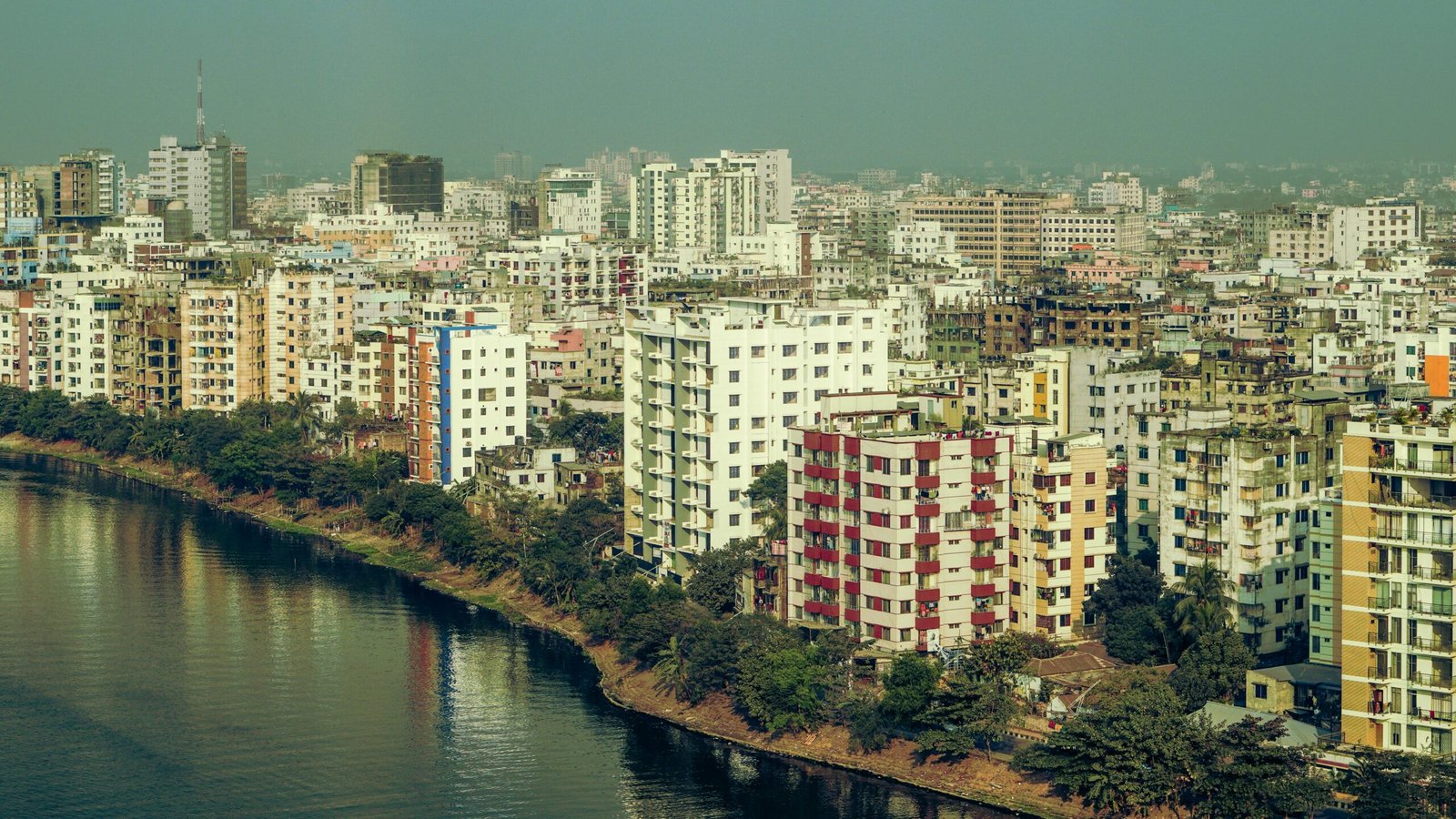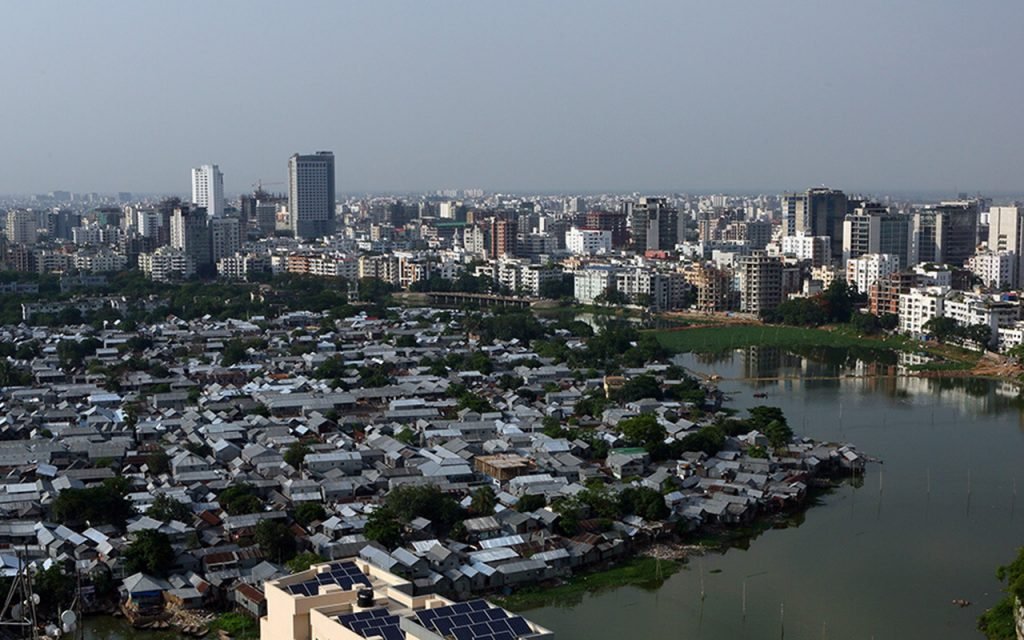Bangladesh has been experiencing rapid and uneven urbanization in recent decades. But, still its level of urbanization is very low compared to internationally. Where, world urbanization level is 52.1%, Bangladesh urbanization level is only 28.4% (source: World Urbanization Prospects: The 2011 Revision).
Analysis of Imbalance Urbanization Patterns in Bangladesh: A Details Regional Growth Analysis
Level of urbanization in Bangladesh is approximately 24% less than world context due to majority of the districts have not get utility facilities, basic services according to the demands of its population and socio-economic and infrastructures also insufficient here. But it is quite happier that, in last six decades its level of urbanization has increased rapidly. A scenario of level of urbanization from in 1951 to 2013 of Bangladesh is given below:
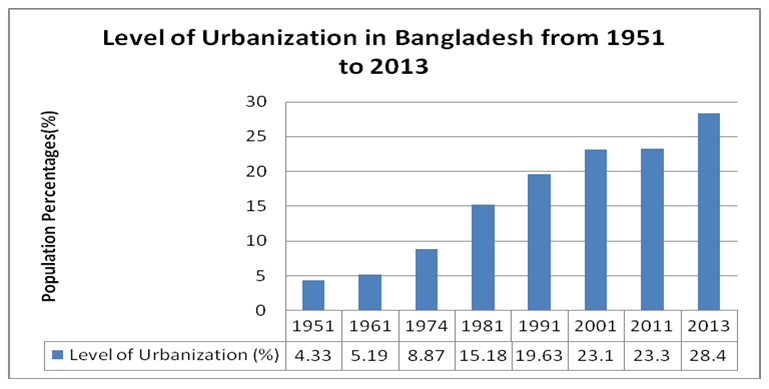
Level of Urbanization
Level of urbanization in Bangladesh are increasing substantially due to industrialization, rural-urban migration, and development of socio-economic infrastructures, wide spatial inequalities in economic growth are playing a part in this regard. Along with urbanization, development will also occur in the equivalent way.
Positive correlation between development and urbanization is apparent within the country context of Bangladesh. This can be explained both in terms of economic growth over time for the country as a whole, and in spatial or regional terms. It may be noted that the contribution (at constant prices of 1984- 85) of the urban sector to GDP of Bangladesh, grew from 25.36 per cent in 1972-73, to 36.39 per cent in 1991-92 and most probably to over 40 percent by now. Correspondingly, the level of urbanization in Bangladesh raised from 7.86 percent in 1974 to 20.15 per cent in 1991 and probably to over 25 per cent by now (CDP, UNFPA paper).
Urbanization of any area depends on many parameters like population dynamics, garbage disposal, electricity, urban housing, transport, health and sanitation, spatial development pattern and others. This study mainly tries to find the highest, medium and lowest urbanized area in Bangladesh in respect of urbanization indicators because taking necessary steps for improving low urbanized area. Otherwise, regional disparity, geographical imbalance will occur and there is also increasing spatial variation of urban development and income.
Methodology
The study examines urbanization rate in different districts of Bangladesh in respect of seven development factors of urbanization such as occupation, structure condition, sanitary facilities, literacy rate, garbage disposal, cooking fuel and electricity availability. Data on population and above mentioned seven indicators were collected from BBS.
After collection of data, they were grouped, categorized and interpreted according to the objectives. Location quotient method and some statistical tools were used to identify the nature and spatial patterns of urbanization in different regions of Bangladesh. Microsoft Excel and GIS were used to analyze the data.
Theoretical Framework
Let’s explain the theoretical framework of this research.
Level of Urbanization
Level of urbanization refers to a process in which an increasing proportion of an entire population lives in cities and the suburbs of cities. It is measured in terms of level of urbanization and speed of urbanization. Level of urbanization is defined as the percentage of total population of an area living in urban areas.
Thus, Level of urbanization = urban population/total population *100
Location Quotient
Location quotient is a convenient way of measuring the relative concentration of an activity in one specific area to the whole. It is easy to use and based on simple calculations. The tool is used here to show urbanization rate of a district relative to the urbanization rate of the country as a whole. Mathematical expression of LQ is based on level of urbanization in district i,

ni= number of urban population ith area.
Pi= total population in ith area
Ni = number of urban population whole country
Pi= total population of the whole country
If the value of LQ for any district is LQ=1.0, it means that Concentration of population in a given region is exactly equal to the country. So, these districts are equal urbanized to the country. If the value of LQ is less than 1.00, it means that Concentration of a population in a region is less than the whole country. As a result, these districts are low urbanized than the country. While the number greater than 1.00 indicates the reverse urbanized area.
Analysis
Using LQ based on the level of urbanization, districts have been classified into three regions these regions are indicating low, medium and high urbanized area. These regions with consisting of number of districts are given below:
Table: Classification of districts according to LQ based on level of urbanization
| Category based on LQ | Frequency of districts | Urbanization Classification | Percentage |
| Up to 0.499 | 26 | Low Urbanized | 40.6% |
| 0.5 – 0.99 | 32 | Medium Urbanized | 50% |
| Above 1 | 6 | High Urbanized | 9.4% |
From the above categorization, it is seen that, majority of the high urbanized districts are situated around Dhaka due to spread effect of Dhaka city. On the other hand, low urbanized districts are situated in lower portion of Bangladesh due to backwash effect of divisional headquarters. So, it is necessary, to find out the development indicators those are responsible for creating discrimination between districts.
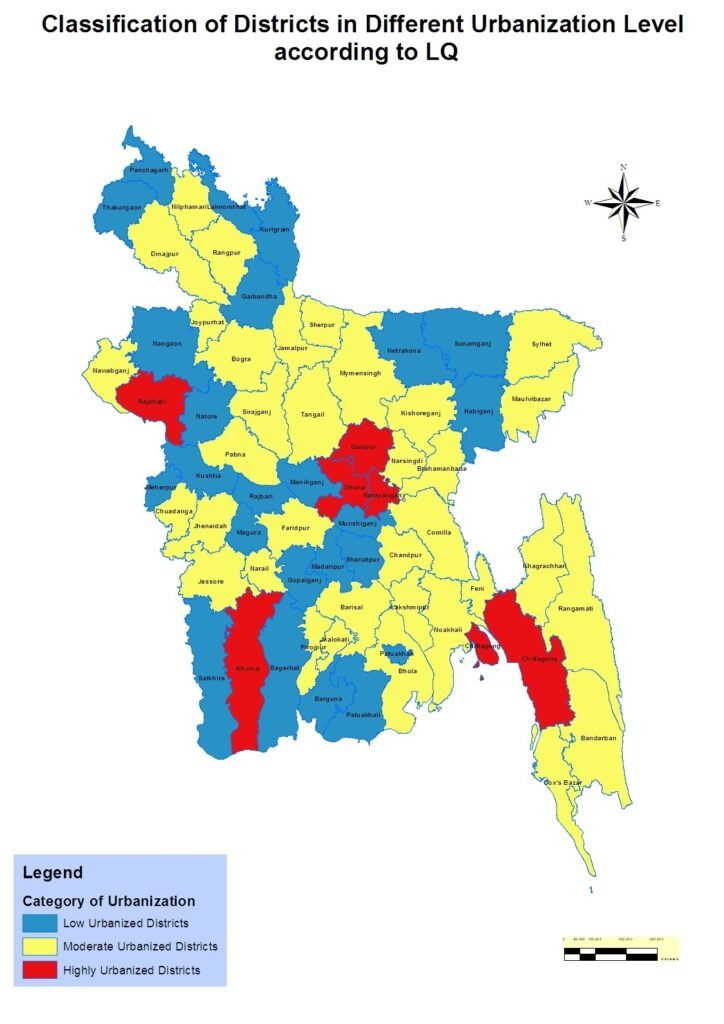
Selecting Urbanization Parameters
Occupation like business, structure condition like pucca house, garbage disposal like managed dustbin, cooking fuel like gas, sanitary facilities, literacy rate, and electricity availability are considered as an indicator of urbanization parameters for the analysis because these parameters are indicating proportionate increasing or decreasing predisposition with level of urbanization. Correlation between these parameters with urbanization is given below:
For analyzing, districts have been separated in two parts based on LQ of urbanization. They are (i) districts where level of urbanization is higher than the country itself (LQ>1) (ii) districts where level of urbanization is lower than the country itself (LQ<1).
| Parameters | Degree of correlation for LQ>1 | Degree of correlation for LQ<1 |
| Literacy rate | R= +0.89 | R= +0.17 |
| Business | R= +0.85 | R= +0.36 |
| Electricity facilities | R= +0.92 | R= +0.31 |
| Sanitation | R= +0.83 | R= +0.27 |
| Pucca building | R= +0.86 | R= +0.38 |
| Garbage disposal managed dustbin | R=+0.79 | R= +0.12 |
| Cooking fuel gas | R= +0.83 | R= +0.19 |
For (LQ>1), all the factors like literacy rate, business, electricity facilities, sanitation, garbage disposal, cooking fuel and pucca building, degree of correlation is increased substantially with every increase in the level of urbanization.
It represents that there exists a higher degree of positive correlation between location quotient of urbanization and above factors. For (LQ<1), urbanization rate does not have any significant bearing on the above factors in case of low urbanized districts. Here represents a lower degree of positive correlation. From these findings overall analysis has been done for identifying urbanization of Bangladesh.
Category Wise Provision of Urbanization Parameters
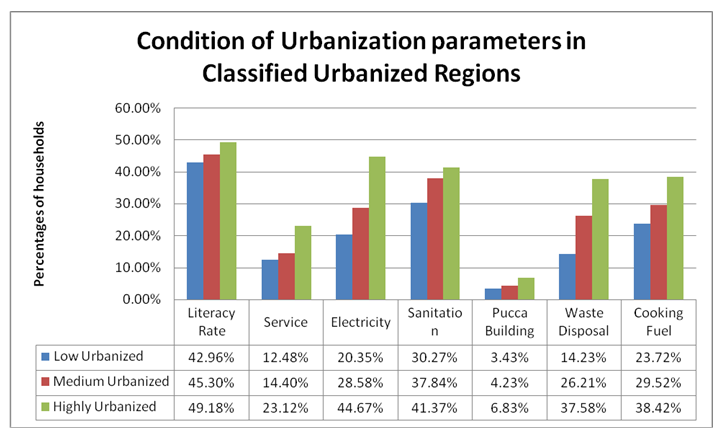
Figure: Condition of Urbanization parameters in Classified Urbanized Regions
Urbanization parameters are improved according to level of urbanization increases. Almost, all of the parameters are increased slightly, but there has been marked variation in electricity facility and pucca building among regions.
Approximately, 35% electricity rate and 18% pucca building are increased from low to high urbanized area. It is interesting that, literacy rate in low urbanized area is quite good than comparing to medium urbanized area. But it is much lower than high urbanized area. Population density, average households’ numbers are more, and income levels are minor in lower urbanized area.
So, the people of low urbanized area cannot be able to bear the educational expenses of their children and after primary education majority of the student give up their educational life.
Comparing Level of Urbanization in Last One Decade
In 2001, 24 districts had plummeted in low urbanized category whereas 27 districts are fall in this category in 2011. LQ value was lowest in Satkhira district and highest in Dhaka district in 2001 where lowest value in Ganibandha and highest in Dhaka district in 2011.
Dhaka districts scenario almost same in last one decade due to huge number of industry is establishing here day by day, people came here for better standard of life and as it is a city of Bangladesh so huge amount of budget is provided in Dhaka district for developing above mentioned five parameters like sanitation, pucca building, electricity and also given more emphasis for improving literacy rate and business activities.
So, it is seen that, in last one decade, every districts level of urbanization is increased than previous years (source: BBS 2001, 2011).
Analysis of Urbanization based on category Level
Intra-regional analysis comprised of analysis of available information within each region (which has been classified according LQ based on level of urbanization).
Low Urbanized Region
For better analysis, low urbanized region is classified in two regions. These regions are named as first rank and second rank. Where, one region LQ ranges from 0.31 to 0.4 and other range from 0.4-05. First category consists of 10 districts and second category consists of 16 districts in 2011 based on LQ of level of urbanization.
First Rank
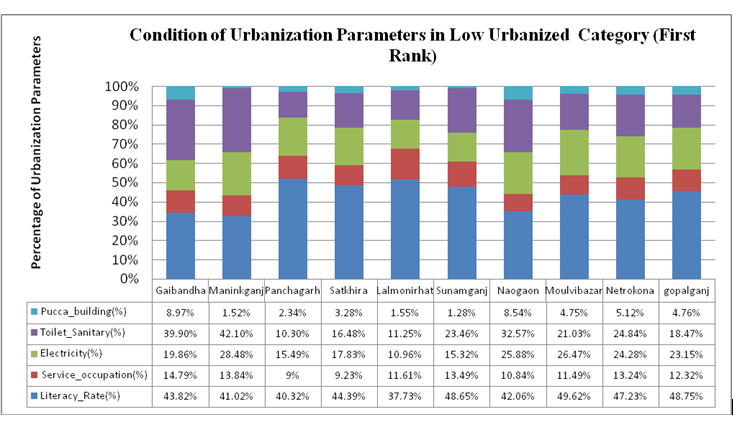
Figure: Low Urbanized Region (first rank) Scenario in respect of Urbanization Parameters
Rural characteristics are dominated in these districts. These districts are mainly dependent on agriculture, poultry and fisheries activities. Among the districts, moulvibazar has the highest literacy rate. Nearly 49.62% people of this district are literate. Literacy rate is lowest in Lalmonirhat district. 37.73% households of in district are literate.
This region has an agro- based economy. Very low percentage of people is engaged in service activities in these regions because agricultural activities are prominent here. Percentage is highest in Manikganj district as its location near to Dhaka city. So, many industries are established here day by day and huge number of people has been employed in this industry. Only 9% households of panchagarh are reliant on business.
Availability of different urban facilities varies widely in this region. Maninkganj is the uppermost district in electricity coverage in low urbanized districts. 28.48% families are under electricity coverage in this region. Electricity availability is high in Maninkganj for huge dependence on industrial sector. Lalmonirhat is the most deprived district in case of electricity coverage. 10.96% households have electricity in their house.
Availability of sanitary facility varies within the range of 10.30% Panchagarh to 42.10% Maninkganj. Pucca households are dominated in Gaibandha district where pucca households connected district is 6.97%. These characteristics show that this region is deprived of urban facilities and far behind to take the opportunity of urbanization facilities.
From the above analysis, most interesting is that, though Manikganj is situated near to Dhaka city, but it falls in low urbanized category due to pucca buildings and literacy rate is quite low in comparing to other regions of Bangladesh and also road and highways connection with other part of country is not good at all.
Second Rank
Districts which are included in this category, their LQ range from 0.4 to 0.49. So, those regions level of urbanization also fall in low urbanized category and also urbanization parameters availability in these regions also very low. Where, highest value in pucca building, electricity and sanitation is found in Munshiganj district.
Service activities also highest combinedly in Munshiganj and Shariatpur district due to close proximity of Dhaka city. As, near to Dhaka city, communication facility is well connected with the all part of the country and industry is established in those regions at a huge rate day by day. In these districts, electricity and sanitation facilities are getting near to national supply rate.
So, as those districts are getting electricity connection more or less near the national average and local government are able to fulfill the demand of its citizen in a rate of national electricity supply. On the other hand, literacy rate is good in Gopalganj district than other district of this category and its value above to national average value.
So, it is seen that, the districts which are situated in this category, tend to achieve the title of medium urbanized district and already some districts near to this achievement.
Medium Urbanized Region
Districts with LQ (based on level of urbanization) value 0.5 to less than 0.99 have been incorporated to the ‘Medium urbanized’ region. For the advantage of analysis, this category has been subdivided into two classes. These two classes are moderately low urbanized and moderately high urbanized. Where, LQ range from 0.5 to 0.75 and 0.75 to 0.99 for moderately low urbanized and moderately high urbanized respectively.
Moderately Low Urbanized
26 districts are fall in this category. Due to this huge number of districts it is not possible to show all of the development parameters in district wise. So, only highest and lowest values are discussed here under this category.

Figure: Availability of parameters in moderately low urbanized region
Highest value for all of the parameters under this category is relatively greater than national rate. So, these districts have in better position than low urbanized districts and also able to meet the demand of its citizen. Literacy rate varies within the range of 27.56% (Kurigram) to 61.23% (Pirojpur).
In last, few years’ government had been taken some initiatives for achieving MDGs (Milium Development Goals) and some NGOs also provided free education classes for the people of this district. In case of business, almost 3 times greater service holder households are increased under this category than low urbanized region. Some other important utility facilities are also quite good here. 57.25% households of Narshingdi have highest electricity connected households and lowest in Kurigram.
In case of sanitation facilities, Feni districts have highest sanitation connected households and its value is 67.48%. Pucca household availability in all 26 district of this region is within the range of 5.27% Sherpur to 12.65% Sylhet. So, from the above analysis, almost all of the districts have better position in respect of above five parameters except Kurigram as this district consists of lowest value in literacy rate and electricity connection. So, this region is needed special attention for improving these parameters.
Moderately High Urbanized
6 districts are fall in this category. So, it is possible to detail analysis of this category. Therefore, detail analysis of these districts in respect of development parameters are given below.
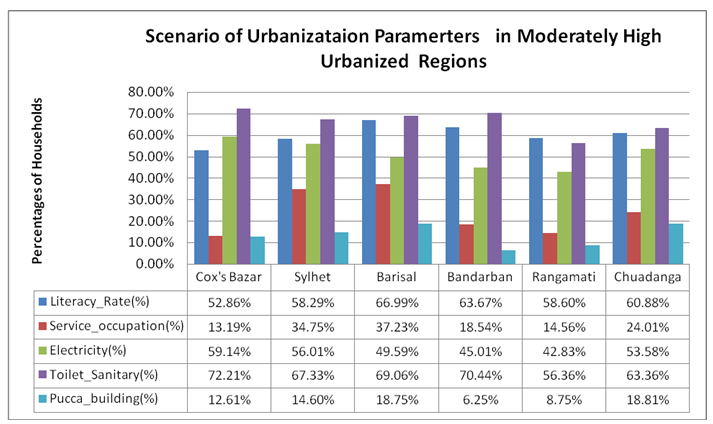
Figure: Availability of parameters in moderately high urbanized region
Lowest literacy rate is found in CoxsBazar district, and this value is 52.86%. From the educational statistics of Bangladesh, it is found that very low percentage of high school and college was established till 2005 in comparing to the proportion of student. Service occupation is very low in Bandarban, Rangamati and Coxs Bazar due to these areas people is concentrated on business activities as all of them are renowned as tourist spot.
Service Facilities
Service activity is highest in Sylhet and Barisal districts as those are divisional city. So, people work on many government and other service offices of those regions. In respect of availability of utility facilities, Coxs bazar has a good position because this district having highest electricity and sanitation connected households under this category. Pucca building structure is highest in chuadanga district and lowest in Bandarban.
As Bandarban, Rangamati well known as a tourist place and located in coastal area, so pucca building structure are not build here rather kutcha and semi kutcha structure are built by people.
Highly Urbanized Area
Only 6 districts are fall in highly urbanized category. There, three districts are situated around Dhaka city and other three districts are the divisional city of Bangladesh.
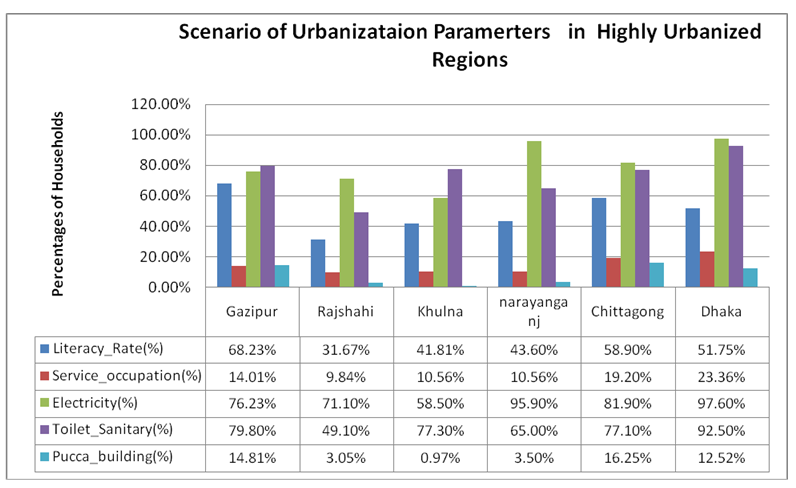
Dhaka is the city of Bangladesh, and it is most urbanized district of this category; attributed by high concentration of urban facilities. It has the highest literacy rate (47.54%), electricity (97.5%) and sanitary facilities (92.5%), pucca building structure (58.56%), service holder (76.56%) in this region.
Dhaka is the center of political, cultural and economic life in Bangladesh. It holds the highest incidence in all the five development parameters. There has been a spread effect due to spontaneous growth of the city. Increased economic activities at the capital stimulating a demand for more raw materials from the periphery and technological advance within it, is being applied to other regions. Urbanization rate in Narayanganj and Gazipur are increasing rapidly owing to this.
These two districts also have direct connections with Dhaka city both by National Highway and Railway services. Business based activities are practiced more in Dhaka and Narayanganj. Narayanganj (23.36%) fall short of Dhaka (24.40%) in business activity with a short margin. This is mostly because Narayanganj is the center of business and industry, especially the jute trade and processing plants, and the textile sector of the country.
Likewise, they have more the upper hand in percentage of households with electricity. On the other hand, three divisional headquarters are also fall in this category these are Rajshahi, Khulna and Chittagong. Due to the central metropolitan area, all of the development parameters are available here and parameters are more than national average supply. So, these six districts are self-sufficient in respect of all of the urbanization parameters and the people in this category are living more happily than another district of Bangladesh.
Discussion
From the above explanation, it is found that, divisional headquarters are extremely urbanized in Bangladesh and Dhaka is also highly urbanized due to the capital of Bangladesh and its surrounding area also well urbanized due to the spread effect of Dhaka city.
Dhaka with LQ based on level of urbanization of 5.65; on the contrary Gaibandha has the lowest LQ value of 0.3. Mainly, rural characteristics are dominated in Gaibandha district and it is placed near the border of northern part of Bangladesh along with far away from any divisional headquarters. For that reason, government educational programmes are not reached to this district along with availability of service facilities also very low.
Among the divisional headquarters Dhaka is most urbanized (LQ=5.65), followed by Chittagong (LQ=1.49), Khulna (LQ=1.2), Rajshahi (LQ=1.17), Sylhet (LQ=0.78), Barishal (LQ=0.8) and Rangpur (LQ=0.54). In regionalization, we are familiar with two concepts for geographical developments. One is spread effect and other is backwash effect. Effects of these two concepts have been found in case of level of urbanization aspects.
Spread out effect means the dynamic propulsive qualities of the growth pole radiate outwards into the surrounding space (John Glasson). Districts which are situated surrounding Dhaka are also highly urbanized due to spread effect from Dhaka city. All of the five parameters are growing fast in Narayanganj, Munshiganj, Gazipur districts as the significant growth of Dhaka city. Gaibandha district is the least urbanized due to backwash effect of neighboring Rangpur district.
Other districts are fall under medium regions and there have a good potentiality for developing these regions in respect of literacy rate, service occupation, electricity, and sanitation and pucca structure.
Conclusion
Bangladesh is a developing country, so, it is natural that, majority of its districts are far away from taking the facilities of basic and essential needs. Only six districts are highly urbanized in this country and approximately 50% of the districts are fall under moderately urbanized portion.
Percentages of Electricity, sanitation facilities are quite better than other three parameters of the districts and in case of pucca structure, literacy rate and service occupation better in Dhaka metropolitan and divisional headquarters of the country.
For achieving the title of middle-income country, it is urgent to develop of the regions at a time and equally. It is also necessary, to ensure equal opportunity in utility, education and occupational aspects with time and providing infrastructures, basic services for all of the regions according to the demand of the people.
References
[1] BBS (Bangladesh Bureau of Statistics). 2011. ‘Population and housing census report 2011’, Bangladesh Bureau of Statistics. Dhaka, Bangladesh.
[2] BBS (Bangladesh Bureau of Statistics).2001; “Bangladesh Population Census 2001”, Community Series, Bangladesh Bureau of Statistics, Planning Division, Ministry of Planning , Government of Peoples Republic of Bangladesh, Dhaka, Bangladesh.
[3] Glasson, J. (1974), AN INTRODUCTION TO REGIONAL PLANNING: Concepts, Theory and Practice, Second impression, Hutchinson & Co Ltd, London.
[4] Wikipedia (2011) “Bangladesh districts ”URL: http://en.wikipedia.org/wiki/Bangladesh_District, last modified on 26 November 2013 at 08:23, retrieved on 29 November 2013 at 06.28 PM (Bangladesh Local Time).

